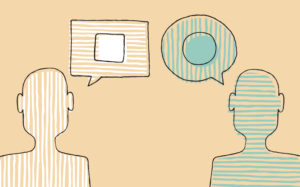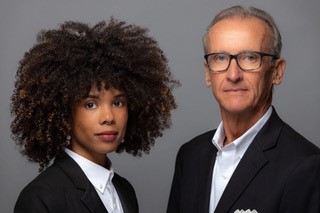
Trainers: Build customer, staff trust by understanding learning styles
By onAssociations | Business Practices | Education
Collision repairers seeking to improve relationships with customers or employees can foster trust by communicating in a way conducive to the other party’s learning style, according to automotive dealership trainer Paul Webb.
Webb and Elle Artison of Paul Webb Training will explain this concept to auto body shops and SEMA exhibitors on Monday, Nov. 4, as the opening session in the Society of Collision Repair Specialists’ 10th annual Repairer Driven Education series.
SCRS said it received “ample attendee recommendations” for the pair after their appearance at the BMW Group Certified Collision Repair Center Conference.
Webb and Artison will offer “Advanced Business Communications – The A-B-C’s Of Building Trust,” from 1-3 p.m. Nov. 4 SEMA Week in Las Vegas. A course description states:
When you build trust YOU INCREASE SALES! Learn easy to use skills that build trust with co-workers and customers. There are three main themes in communication: 1- Building trust with the sales staff; 2- Matching co-worker strengths with job responsibilities to reduce employee turnover; 3- Self-testing forms that determine learning and buying styles in both co-workers and customers. Increase skills in these areas and you’ll increase sales!
The duo gave us a preview of the subject matter in an interview Tuesday, and Artison examined it Friday in a piece for Agent Entrepreneur.
Webb said the auto industry and supporting industry has a reputation of being untrustworthy, and the talk will counter that problem with techniques that could be used in sales, recruiting and retention and job skills — “whatever it is.” It would apply to those working a booth, buying products or speaking to an audience, he also said.
“It has such a broad appeal,” he said.
Trust can be shaken by simple miscommunication, and “it’s immediate,” Webb said. This miscommunication might simply occur because one party delivered the message in a format unsuitable to the other party, according to Webb.
“It may not be intentional,” Webb said.
He gave the example of texting a message to a person who wanted a phone call or a shop foreman whose verbal request to an owner goes in one ear and out the other — as opposed to a text message and Post-It Note.
In the first instance, the recipient has an auditory learning style. In the second, the owner is a visual learner. About 35 percent of the population learns best visually, 25 percent has an auditory learning style, and the other 40 percent are “kinesthetic” — which involves hands-on learning and a “gut feeling” using all senses, according to Webb. Match how you communicate to your audience’s style, and voila.
“As simple as this sounds, it’s not used,” Webb said. But once you learn about it, it can be an “‘aha’ moment,” he said, giving the examples of recognizing why one doesn’t like a certain supplier or a parent realizing why one’s child does badly with homework.
Someone approaching a SEMA booth might not want to hear a pitch; they’d rather see a brochure, Webb said. Recognizing that allows the exhibitor to communicate in a manner that doesn’t erode trust — and then maintain and build on that, with the visual learner looking forward to a new text and video, he said.
Webb said the breakdown of learning styles might vary with demographics. People in their 70s who grew up with radio are more likely to be auditory learners, he said. He predicted kinesthetic learning would fall to 35 percent of the population and visual learning preference rise to 40 percent given the rise of iPhones and online shopping. Fewer in-person interactions with other humans means less kinesthetic communication, he said.
Artison said business owners must respect different demographics and their learning styles and not jump to conclusions like millenials had no work ethic. Perhaps they needed to physically perform the task to learn how to do it, she said. Webb said skilled tradesmen and -women are going to skew more kinesthetic than academic professions, and business owners needed to recognize that.
Asked how to recognize a learning style quickly to close a sale rather than blow the limited time one has with a shopper, Artison said: “That’s our presentation.”
So you’ll have to get the answer from Webb and Artison on Monday, Nov. 4, at SEMA.
Repairers can see Artison again during the Repairer Driven Education series at Friday, Nov. 8’s rapid-fire IDEAS Collide event. Similar to TED Talks, Artison and the nine other speakers are tasked with offering solutions or bold ideas in presentations limited to 10 minutes each. Her talk “6 Bridge Statements – Getting To Yes’” teaches how to achieve a “yes” answer by taking into account the brain’s tendency to take words literally.
Sign up for Webb and Artison’s Nov. 4 class or IDEAS Collide individually for $75 each during early registration, or get access to both events and everything else that week by purchasing the $375 full series pass. The latter lets you into any Monday, Nov. 4-Wednesday, Nov. 6 Repairer Driven Education course, the three-part OEM Collision Repair Technology Summit and the Sky Villa afterparty on Thursday, Nov. 7, and IDEAS Collide on Friday the 8th. Learn more at www.scrs.com/rde.
More information:
SCRS Repairer Driven Education registration
Images:
Miscommunication can occur simply because the message isn’t delivered in a format conducive to the other party’s learning style, according to Paul Webb of Paul Webb Training. For example, a text message to an auditory learner. (CurvaBezier/iStock)
Paul Webb and Elle Artison of Paul Webb Training. (Provided via SCRS)


